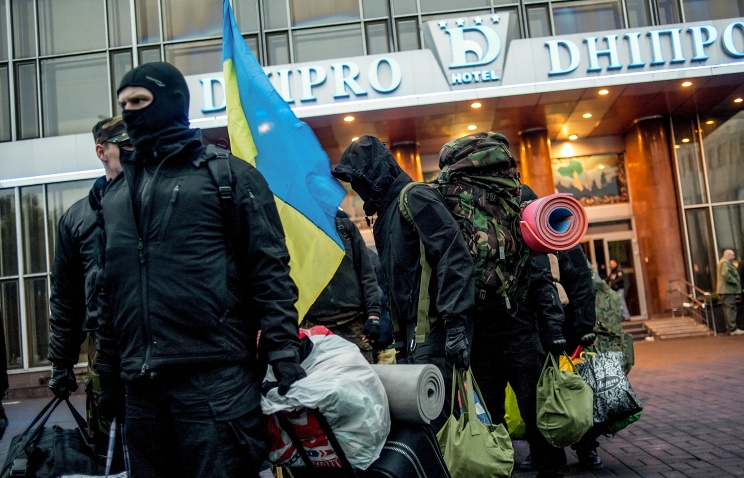
© EPA/Konstantin Ivanov
Some 4,000 combatants supporting the Kiev authorities have been brought into Odessa, Georgy Fyodorov, deputy head of the Russian Civic Chamber's Committee for Coordination of Aid to Residents of Ukraine said Wednesday.
"Very alarming reports are coming in from our friends in Odessa," he said. "They suggest that control over the city has practically shifted to (tycoon Ihor) Kolomoisky because Igor Palitsya, the new governor of the Odessa region, is his henchman."
"Unfortunately, we have reports that
armed militants of the Right Sector, fighters of the Dnipr and Kyiv-1 special task force battalions, and ultras of the FC Dnipro have been brought into the city and the overall number of the combatants propping up the Kiev regime exceeds 4,000 there now," Fyodorov said.
"The most dangerous thing is that
local police have handed them the lists of the pro-federation movement activists," he said. "In addition, we have the information the whole city is blocked by checkpoints and traffic inside is practically paralyzed."
Fyodorov said the reports coming from Odessa were "a cry for salvation". "People are asking the Public Chamber and me personally to appeal to international organizations and to the authorities in Kiev to avert the planned actions of terror and to stop the city's slide into genocide."
"We're working on this very scrupulously now and watching the situation inside and outside of the city," he said.
Powerful Ukrainian oligarch Ihor Kolomoisky was appointed governor of Dnipropetrovsk region by the incumbent government in March 2014.
What happened in OdessaRiots in Odessa started May 2 in the afternoon, when football fans from Kharkiv, as well as Right Sector activists and representatives of the so-called Maidan self-defense forces from Kiev staged a march on the city's streets. In the course of this action, clashes with Ukraine's federalization supporters began. The radicals set on fire the regional House of trade unions and the tent camp on the Kulikovo Field square, where signatures were being collected for holding a referendum on Ukraine's federalization and the status of Russian language.
According to official data,
46 people died and 48 people are reported missing. Many Ukrainian politicians, including lawmaker Oleh Tsariov and member of Odessa Regional Council Vadim Savenko, believe these figures are understated. They claim that there are about
116 casualties, and the authorities are keeping it back and trying to cover tracks of the tragedy.
"We really know what in fact happened to the casualties - they were just included in the 'missing' column," Savenko told journalists. He accused the authorities of "an attempt to cover the Right Sector militants and activists of the so-called Maidan self-defense forces who staged a massacre in Odessa". It is noteworthy that head of Odessa's police Petro Lutsyuk, who was dismissed soon after the tragedy, also demanded from the ex-governor Vladimir Nemirovsky to withdraw the militants sent by Kiev authorities.
"Since a big number of people without supervision were staying in Kiev, the authorities decided to send these units to Odessa. We do not need this. They arrived to destabilize the situation," Lutsyuk said at a regional council's session on April 4. He added that "these militants have set up in the region 12 checkpoints with an unclear legal status, where more than 500 people are in rotating teams". The police also discovered a warehouse that they equipped to store weapons and supplies. However, Nemirovsky supported the militants, noting that "they are needed to control the activities of the police".
The new head of Odessa's police, who succeeded Lutsyuk, Ivan Katerinchuk, ordered the police officers to open effective fire in case of attacks on law enforcement representatives. "The time of uncertainty is over. We have held consultations and set tasks. In case of attacks on police precincts and stations we will act in compliance with law - first, a warning shot in the air, and then we will apply lethal force. Not a single group carrying weapons, either melee weapons or firearms, will be able to move through the city, regardless of their political views," he stated. According to Katerinchuk, order in Odessa will be provided not only by the already available police forces, but also by the Storm special task unit, set up by new authorities from volunteers and employees of private security agencies.
62 people injured during the May 2 events remain in Odessa's hospitals, with 26 of them in critical condition, who are placed in intensive care.
Reader Comments
to our Newsletter